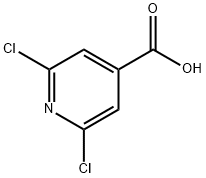|
|
| | 2,6-Dichloroisonicotinic acid Basic information |
| Product Name: | 2,6-Dichloroisonicotinic acid | | Synonyms: | 2,6-Dichloroisonicotinic acid ,98%;CGA-41396;2,6-Dichloropyridine-4-carboxylic acid,2,6-Dichloroisonicotinic acid;2,6-Dichloropyridine-4-carboxylic acid, 4-Carboxy-2,6-dichloropyridine;2,6-Dichloropyridine-4-carboxylic acid 98%;2,6-Dichloropyrdine-4-carboxylic acid;4-Pyridinecarboxylic acid, 2,6-dichloro-;BUTTPARK 43\57-46 | | CAS: | 5398-44-7 | | MF: | C6H3Cl2NO2 | | MW: | 192 | | EINECS: | 611-076-5 | | Product Categories: | Intermediate of Irinotecan;Pyridines;Pyridine;Chloropyridines;Halopyridines;Carboxylic Acids;pharmacetical;Carboxylic Acids | | Mol File: | 5398-44-7.mol |  |
| | 2,6-Dichloroisonicotinic acid Chemical Properties |
| Melting point | 209-212 °C(lit.) | | Boiling point | 437.8±40.0 °C(Predicted) | | density | 1.612±0.06 g/cm3(Predicted) | | storage temp. | Keep in dark place,Sealed in dry,Room Temperature | | solubility | soluble in Methanol | | form | powder to crystal | | pka | 2.63±0.10(Predicted) | | color | White to Brown | | Water Solubility | insoluble | | InChI | InChI=1S/C6H3Cl2NO2/c7-4-1-3(6(10)11)2-5(8)9-4/h1-2H,(H,10,11) | | InChIKey | SQSYNRCXIZHKAI-UHFFFAOYSA-N | | SMILES | C1(Cl)=NC(Cl)=CC(C(O)=O)=C1 | | CAS DataBase Reference | 5398-44-7(CAS DataBase Reference) | | NIST Chemistry Reference | 4-Pyridinecarboxylic acid, 2,6-dichloro-(5398-44-7) |
| Hazard Codes | Xi | | Risk Statements | 36/37/38 | | Safety Statements | 26-36-37/39 | | WGK Germany | 3 | | HazardClass | IRRITANT | | HS Code | 29333990 |
| | 2,6-Dichloroisonicotinic acid Usage And Synthesis |
| Chemical Properties | off-white to beige or light brownish powder | | Uses | 2,6-Dichloroisonicotinic acid is a derivative of isonicotinic acid (I821760). Treatment of oat cultivars using 2,6-dichloroisonicotinic acid results in an increased accumulation of avenathramide. 2,6-Dichloroisonicotinic acid is a well known inducer of plant resistance and induces the transcription of ZmNAC100 transcription factor. | | Definition | ChEBI: A member of the class of pyridines that is isonicotinic acid which is substituted by chlorine at positions 2 and 6. | | Agricultural Uses |
The best characterized synthetic inducer of resistance, 2,6-dichloroisonicotinic acid and its methyl ester (both are referred to as INA) were the first synthetic compounds reported to activate a phenocopy of bonafide systemic acquired resistance (SAR). 2,6-dichloroisonicotinic acid was used as an abiotic resistance inducer against bacterial spot disease of tomato caused by Xanthomonas perforans. INA was found to protect cucumber, tobacco, arabidopsis, sugar beet, bean, rose, barley, and rice from several pathogens[1].
| | Mode of action | In tobacco, salicylic acid (SA) and 2,6-dichloroisonicotinic acid (INA) induce the same nine classes of genes (including the PR genes) that are expressed systemically after tobacco mosaic virus (TMV) infection. In contrast to many other abiotic inducers of PR gene expression and enhanced disease resistance, such as polyacrylic acid and thiamine, INA does not stimulate the accumulation of SA or its glucoside in treated tobacco plants. The strong correlation between biological activity and the ability to bind and inhibit catalase suggests that the physiological effects of INA, SA, and their active analogs are mediated by the same mechanism of action: inhibition of catalase's ability to degrade H202[2].
| | References |
[1] S. Chandrashekar, S. Umesha. “2,6-Dichloroisonicotinic acid enhances the expression of defense genes in tomato seedlings against Xanthomonas perforans.” Physiological and Molecular Plant Pathology 86 (2014): Pages 49-56.
[2] Uwe Conrath. “Two inducers of plant defense responses, 2,6-dichloroisonicotinec acid and salicylic acid, inhibit catalase activity in tobacco.” Proceedings of the National Academy of Sciences of the United States of America 92 16 1 (1995): 7143–7.
|
| | 2,6-Dichloroisonicotinic acid Preparation Products And Raw materials |
|